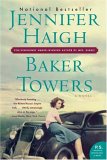Book Club Discussion Questions
In a book club? Subscribe to our Book Club Newsletter!
Please be aware that this discussion guide will contain spoilers!
Introduction
One of the literary world's rising stars, Jennifer Haigh earned
coast-to-coast raves and the PEN/Hemingway Award for her debut, Mrs. Kimble.
In her second novel, Haigh not only meets but surpasses the expectations
established by her first book. Baker Towers traces the lives of three
generations in a community that tenderly echoes the American experience. A
family album peopled with vivid characters, this is the story of an America long
past, a haunting meditation on the passage of time.
Polish immigrant Stanley Novak worked the night shift in the coal mines of
western Pennsylvania, in close-knit Bakerton, a town named for its mines. When
he dies suddenly, his widow, Rose, is left to raise their five children. The
oldest son, George, becomes a soldier in World War II. Their daughter Joyce will
join the military as well, hoping the Air Force can give her opportunities that
working-class Bakerton could not. Her sister Dorothy takes a job in Washington,
D.C., where her fragile beauty and romantic ideals make her dangerously
vulnerable. The two youngest children grow up without a father while seeking
their places in a rapidly changing world. But at each turning point in love or
fortune or work, the siblings can't forget where they come from. Each, in his
own way, feels the inexorable pull of home.
Evoking a long-lost time and place with powerful precision, Baker Towers
follows the Novak family through three decades of sweeping change. You'll not
soon forget their story.
Discussion Questions
- Do the opening paragraphs depict Bakerton as an oppressive community or a
utopia, or a combination of the two? Viewing the town itself as a character,
how would you describe its biography?
- Discuss the social distinctions embodied in the Novak family. What roles
did society prescribe for Rose and Stanley, based on gender and class? Did
their children lead more fulfilling lives than their parents?
- Do you attribute the differences between the siblings to temperament or
circumstance? How was each one affected by Stanley's death?
- How would you characterize the author's narrative style? What is the
effect of her choices regarding scenery, storyline, and other aspects of the
novel's architecture?
- Before meeting Rose, Antonio Bernardi had never seen an Italian wife on
Polish Hill. In what ways has the American immigrant experience, and the
character of immigrant communities, changed over the past century?
- George's parents named him after George Washington rather than calling him
Stanley Novak, Jr. They wanted to emphasize the American, not Polish, aspect
of his identity. What freedoms and restrictions are illustrated by George's
marriage, and his wistful love of Ev? What enables his son to embrace
Bakerton?
- What keeps Dorothy in Washington, D.C., in a life defined by
repetitiveness and sterility for so many years? How does her definition of
morality shift throughout the novel? What does her perception of the world
reveal about her perception of herself?
- Joyce's intellectual drive is accompanied by a strong dose of
practicality. Do you view her as the family's savior or as a wet blanket?
Why do so many of her efforts go unappreciated?
- Is Sandy the antithesis of George, or a reflection of him? Does either
brother remind you of Stanley?
- What does Lucy convey about the nature of hunger, and the nature of
beauty? What is the significance of her eventual role as healer?
- The tragic mine disaster shapes the novel's conclusion, leading to the
image of Amish settlers arriving in Saxon County. What dies along with
Eugene Stusick and his co-workers? What allows something new to be reborn in
this community?
- Who are the novel's most prosperous characters? How do you define
prosperity in your own life? What family legacies have shaped your dreams?
- Mrs. Kimble also conveyed a theme of illusion versus reality.
Compare the ways in which that theme plays out in both novels.
Copyright Harper Collins 2005
Unless otherwise stated, this discussion guide is reprinted with the permission of Harper Perennial.
Any page references refer to a USA edition of the book, usually the trade paperback version, and may vary in other editions.
